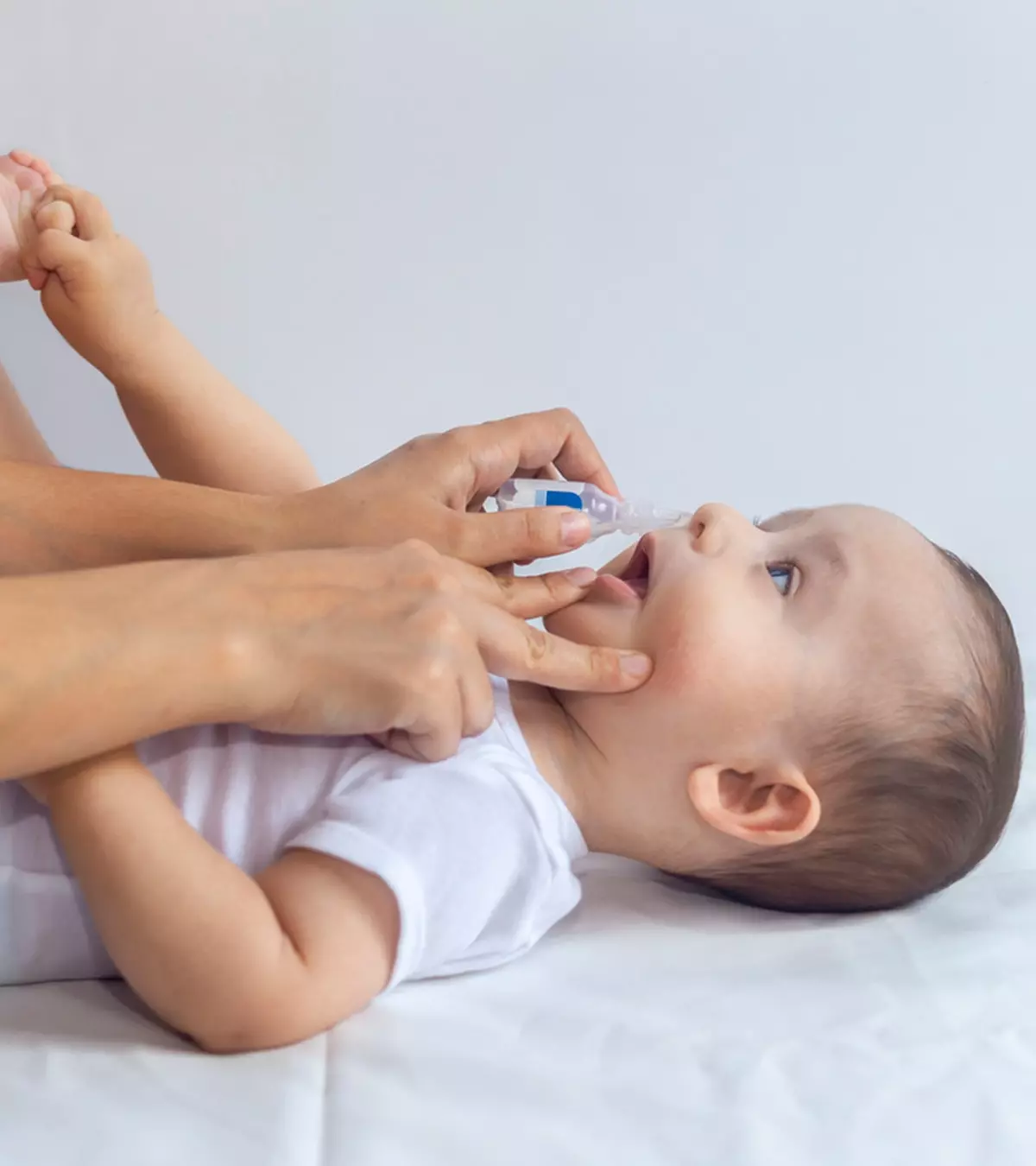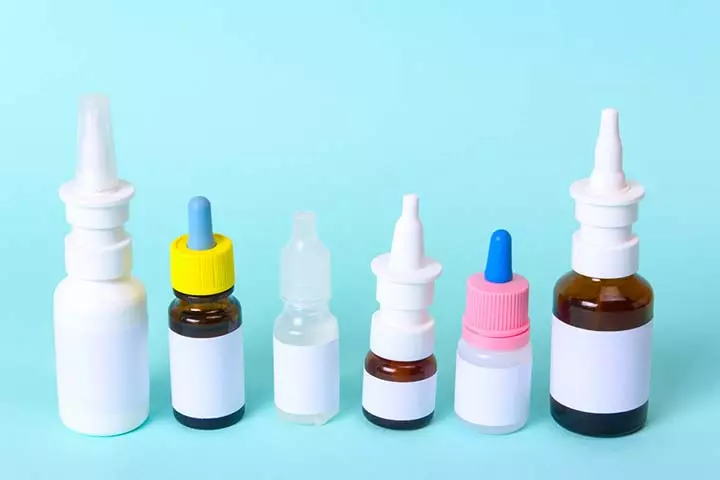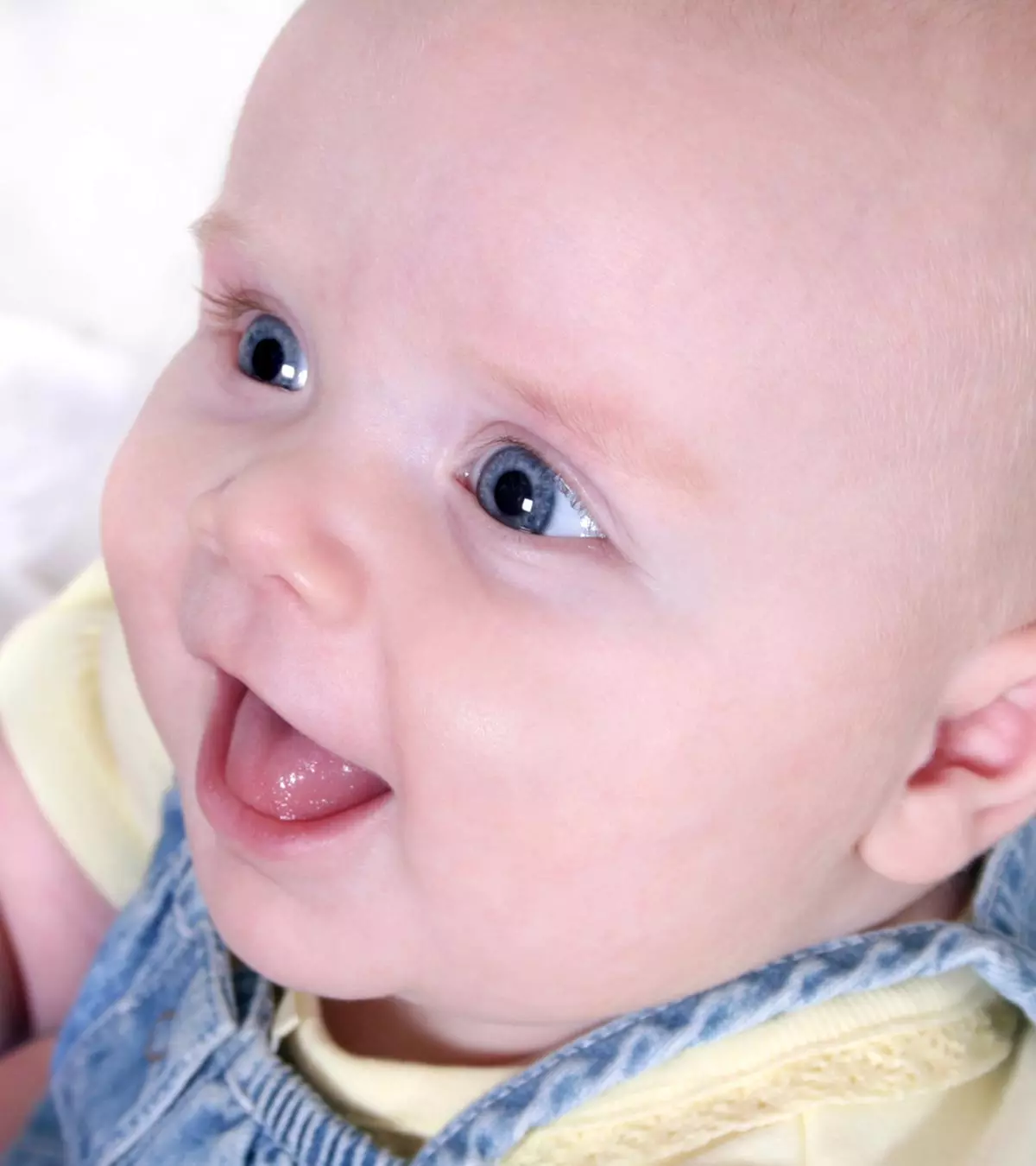
Image: ShutterStock
Nasal saline drops for babies can be useful for relieving nasal congestion, which usually occurs due to cold and other respiratory illnesses

. Babies and toddlers may experience seven to eight episodes of cold a year (1).
Since babies are obligate nasal breathers, a stuffed nose may affect their feeding and sleeping routines and make them fussy (2). Hence, you can consider using nasal saline drops, a liquid mixture of distilled wateriWater boiled until vapor is released, and the vapor is condensed back into the water. and salt. They are typically non-medicated and considered safe for babies.
Read on as we tell you more about how nasal saline drops work, how you can make them at home, and the correct way to administer them to a baby.
Key Pointers
- Use a nasal bulb with saline drops to clear mucus from the baby’s nose.
- Nasal saline drops can be purchased or made at home using boiled distilled water and non-iodized salt.
- Do not give nasal saline drops to babies more than three times a day, or mix it with any medication.
How Do Nasal Saline Drops Work?

The saline drops and nasal sprays work by passing through the delicate nasal membrane and reducing the excess mucus secretion (3). It neither irritates nor harms the nasal tissues, and is one of the safest ways to clean your baby’s nose.
Pediatricians recommend using a nasal bulb or a bulb syringe along with the nasal saline drops to suction and clear the mucus from an infant or baby’s nose. The saline solution also thins the congested or hardened mucus within the nose, making it easier to suction the mucus through the nostrils.
Nasal saline drops could provide the following benefits to children with nasal congestion:
- The use of nasal saline to remove accumulated mucus has been noted to reduce the risk of other infections, such as ear infections (4).
- It could reduce the need for other medications, such as antihistaminesiDrugs used to treat allergies. , which could have potential side effects.
- The timely use of nasal saline may help improve the function of cilia, the hair-like structures on the cells of the nasal and sinusiAir-filled cavities near the nose. tissues (5). The cilia play an essential role in clearing the nose and sinuses of excess mucus.
- Infections could inflame nasal tissues. The saline solution could narrow down the blood vessels that lead to inflamed nasal tissue. It could help reduce inflammation and make it easier for the baby to breathe (6). It may also improve the flow of mucus.
- Nasal aspiration after saline administration may help rinse potential allergens, such as pollen and dust. Allergies could cause excess mucus secretion, which can lead to a blocked nose.
 Quick fact
Quick factHow To Make Nasal Saline Drops For Babies At Home?

You may purchase nasal saline drops from a store or may make it at home. Here the steps to make nasal saline drops at home (7).
- Wash your hands thoroughly to prevent any contamination.
- Purchase distilled water or use filtered tap water. Boil the distilled or tap water for a minute.
- Cool the water until it turns warm. Drop a few drops on your skin to check if it is comfortably warm.
- Pour a cup (236ml / 8fl.oz.) of warm water in a clean container.
- Add 1/4th teaspoon of plain non-iodized salt and stir it until the salt dissolves completely. The nasal saline drops are ready.
You must discard any unused saline. Make a new batch of nasal saline drops each time you need it.
 Quick tip
Quick tipHow To Administer Nasal Saline Drops?

Nasal saline drops are easy-to-use and gentle. Before you begin, you will need a container of saline drops, a nasal dropper, a bulb syringe, and tissue papers or washcloths to collect the mucus.
New York-based board-certified pediatrician Dr. Cherilyn Cecchini suggests, “Administer nasal drops to your baby, leaving them in the nose for approximately five minutes to achieve the desired effect. Hold the baby cradled in your arms during this period. If the baby starts to cough, allow them to sit up or assist them in sitting upright. You can use two to six drops of saline as often as needed. Generally, two to six times in one day should be frequent enough to alleviate symptoms without causing irritation from gentle suctioning.”
Here is how to administer nasal saline drops to a baby (8).
- Wash your hands thoroughly before you begin.
- Lay your baby on their back. You may swaddleiWrap a baby in a cloth to protect them from natural reflex. the baby or let another person hold the baby to prevent them from moving.
- Use a nasal dropper to drop one or two drops of saline drops in the baby’s nostril. You must administer the saline drops to one nostril at a time.
- Leave the saline for a minute. It is okay for the baby to sneeze, and you need not add more saline. If the baby becomes cranky, distract or soothe them.
- Take the bulb syringe, squeeze out all the air, keep the bulb compressed so that air does not re-enter, and gently insert the narrow tip into the baby’s nostril. Do not push the tip far; insert it as far it goes without resistance.
- Release compression on the bulb. It will draw the mucus.
- Remove the bulb’s tip from the nostril. Squeeze and release the collected mucus in a tissue paper or into the sink.
- Repeat the same process with the other nostril.
- Once done, wipe out any mucus around the baby’s nostrils with clean tissue paper.
- Wash the bulb syringe and nasal dropper with soapy water and leave it to dry. Discard any remaining nasal saline water.
Precautions To Take While Using Nasal Saline Drops

The following precautions help in the safe use of nasal saline and suctioning of mucus (8).
- Do not administer the nasal saline drops more than three times a day as it may make the nasal passages sore.
- Do not mix or use the saline with other medications.
- Do not use medicated nasal saline drops unless directed by the doctor.
- Your baby’s doctor may recommend a specific number of drops or frequency of administration. Stick to the doctor’s prescription.
- Administer the drops 15 to 20 minutes before a feeding session to prevent the risk of gagging or vomiting while feeding. Never administer nasal drops after the baby has been fed.
- Do not push the bulb syringe too far into the nose. Aim it outwards (towards the cheeks) instead of aiming to the middle (towards the nasal septum).
- If the baby has a cold, flu, allergies, or infections, it is ideal to sterilize the bulb syringe and nasal dropper by boiling them or washing them with absolute alcohol. It would ensure that the equipment is sterile and prevent reinfection.
- Do not share the same nasal dropper and bulb syringe with other babies.
Possible Side Effects Of Nasal Saline Drops

Saline nasal drops are safe and seldom cause any problems. However, using saline nasal sprays and drops may cause the following side effects in some babies (3).
- Excessive use of saline drops may cause soreness of nasal tissue and the skin around the nostril.
- Babies with sensitive nasal passages may experience minor bleeding and a stinging sensation in their noses.
- Some babies may gag or vomit due to the saline.
- Some saline liquid may trickle from the nose into the nasopharynx and reach the mouth and the throat. It may cause some babies to cough. Older toddlers and children may experience hoarseness of voice for some time.
- Medicated nasal saline may cause other side effects, depending on the medicine in it.
Frequently Asked Questions
1. Can I use saline drops while my baby is asleep?
You may use saline drops for nasal congestion relief before the baby goes to sleep (9). Do not administer it while the baby is asleep. Instead, you may use a cool-mist vaporizer near their crib to keep them comfortable during sleep (10).
2. Do saline drops help relieve cough in babies?
Cough reflexes are not well developed in babies; therefore, nasal congestion may make them uncomfortable. Saline drops, when used along with suction, may help relieve cough in babies by reducing mucus (11).
3. Can saline drops be used for adults as well as babies?
Yes. Saline drops can be safely administered to babies, children, and adults to help relieve nasal congestion. However, the guidelines for its administration and safety may differ. For example, babies may be advised to use pharmacy-bought saline products as they come packaged in a suitable device for use and the right strength for safety. Whereas adults may use a homemade saline rinse (3).
4. What can I do if my baby has an allergic reaction to saline drops?
If you observe your child exhibiting symptoms of allergy to saline drops, it is advised to consult with a doctor immediately and discuss their symptoms.
5. Do I need a prescription to get saline drops for my baby?
No. Saline drops can be bought from a drugstore without the requirement of a prescription (12).However, if you notice symptoms like persistent congested nose, breathing difficulty, or fever along with a congested nose, do not self-medicate your baby and consult a pediatrician for further evaluation and treatment.
6. Can nasal saline drops be used for a baby’s allergy or dry nose?
Yes. Babies with allergies and dry noses can be given nasal saline drops to moisten and treat the dryness inside the nose. It can soften the dried and thick, crusty mucus inside the nose, clearing the airway.
A blocked nose can be annoying for babies. It can hamper feeding, eating, and even breathing. Saline nasal drops for babies are helpful as they thin the mucus and help keep airways open. Thin mucus is easy to be suctioned out of the nose. You can also make a saline solution for babies to manage nasal dryness and runny nose at home. Saline solution moisturizes the nasal lining, which helps prevent nasal lining irritation. Consult a healthcare professional if, with a blocked nose, your baby exhibits other symptoms, such as cough or fever. Also, consult with your baby’s doctor to know if the saline nasal drops are appropriate for your baby’s specific needs.
Infographic: Other Ways To Clear A Stuffy Nose
Nasal drops are highly effective in clearing a stuffy nose, but it is not always easy to keep the baby calm and steady through it. This infographic suggests other methods to clear a baby’s nasal congestion that can be easier for the parent to perform.
Some thing wrong with infographic shortcode. please verify shortcode syntax
Learn how to treat your baby’s cold with nasal saline and suction from the experts at Boys Town Pediatrics. Get tips on how to keep your baby comfortable and healthy.
References
1. Should I Be Worried If My Child Gets Sick Too Often?; University of Utah
2. Treating Your Baby’s Cold: Nasal Saline & Suction; Boys Town Pediatrics
3. Saline nasal sprays, drops & rinses; Health Navigator
4. G Chirico, G Quartarone, and P Mallefet, Nasal congestion in infants and children; National Library of Medicine
5. Nasal Saline Rinse Children’s; Minnesota
6. How To Use Nasal Drop; MyHealth; Malaysia
7. Suctioning the Nose with a Bulb Syringe; Nationwide Children’s Hospital
8. Suctioning the Nose with a Bulb Syringe; Cincinnati Children’s Hospital
9. Bronchiolitis; Nemours KidsHealth
10. Nasal Congestion (Infant/Toddler); Fairview
11. Suctioning Your Child’s Nose and Mouth; Children’s Hospital of the King’s Daughters
Community Experiences
Join the conversation and become a part of our nurturing community! Share your stories, experiences, and insights to connect with fellow parents.
Read full bio of Dr. Anuradha Bansal
- Dr. Cherilyn Cecchini is a board-certified pediatrician with about seven years of experience. She did her medicine at Thomas Jefferson University and is the founding member of the medical advisory board at Andwise.
 Dr. Cherilyn Cecchini is a board-certified pediatrician with about seven years of experience. She did her medicine at Thomas Jefferson University and is the founding member of the medical advisory board at Andwise.
Dr. Cherilyn Cecchini is a board-certified pediatrician with about seven years of experience. She did her medicine at Thomas Jefferson University and is the founding member of the medical advisory board at Andwise.
Read full bio of Dr. Ritika Shah
Read full bio of Rohit Garoo
Read full bio of Shinta Liz Sunny
















